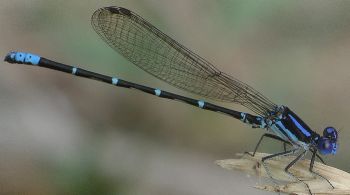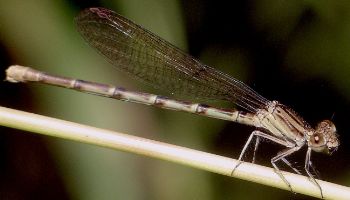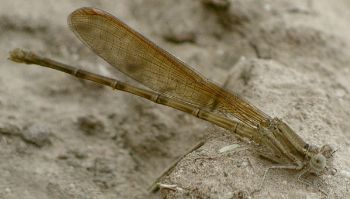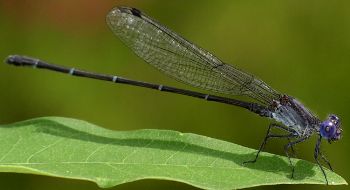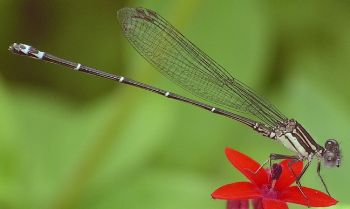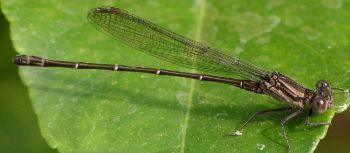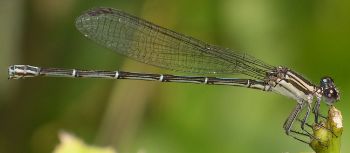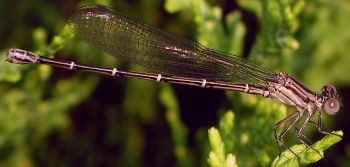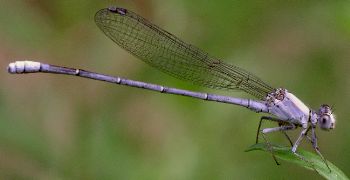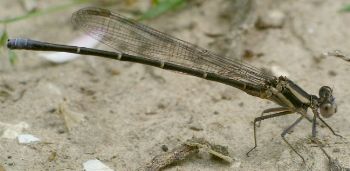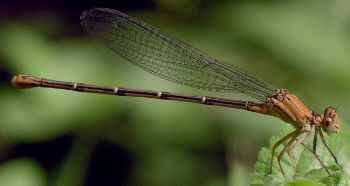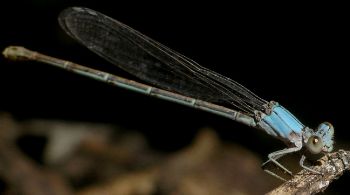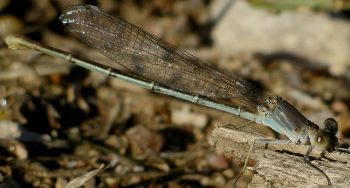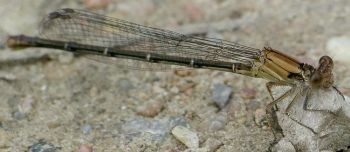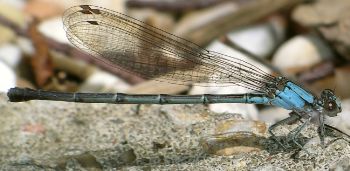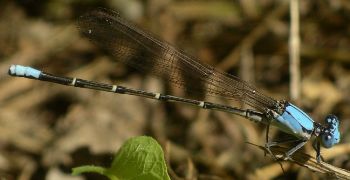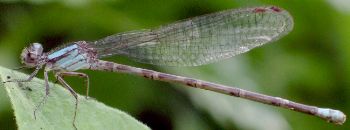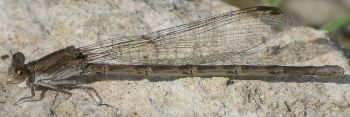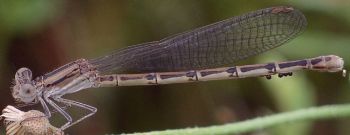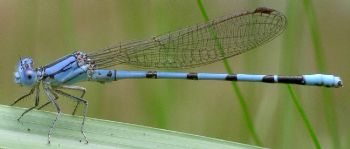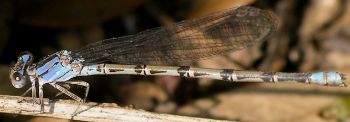
| Coenagrionidae ~ Pond Damsels |
page 1 ![]() page 2
page 2
|
The previously mentioned genus, Argia, contains the greatest number of species in our area. These are also rather large, at least compared to other pond damsels. This genus is the one that often gives beginners fits, as the identifications sometimes rest on very small details. Usually, certain species will predominate in a small area, so it is possible to identify ambiguous females by the males with which they are associating. Of course, mating pairs are the best clue.
The Blue-ringed Dancer (Argia sedula) is not terribly common, nor is it rare. It's one of those that shows up occasionally, in a variety of places. The males are striking in that they are quite dark compared to other dancers, but not in a dusty way. Their heavy black markings are sharp and distinct over various shades of blue, with the abdomen having so much black on top that it makes it look like there are small blue rings on it. Actually, the blue also extends a bit on the underside, but that is not evident unless the insect is viewed from the side. The bright blue tip on the abdomen is always very easy to see. Females are one of the hardest species to identify, as they are brown, with vague markings that are simply darker brown. They sometimes show a bit of the same markings as males, but much more indistinct. One very useful trait is that their wings are sometimes noticeably brown-colored.
Another damselfly with a mostly black abdomen is the Dusky Dancer (Argia translata). At times, this can be a very common species. Mature males are rather unmistakable. They have deep blue eyes, and are mostly black with thin light rings on their abdomen segments. They have a whitish powdery look that is heaviest at the base of the thorax and fades towards the top. The tip of the abdomen is black. The dustiness that characterizes mature males only develops gradually, and freshly emerged males are much different in appearance. They have very clearly marked black and light blue thoraxes, and there are intricate light blue and black markings on the top of the abdomen tip. There is also a form of the male in which the light blue is replaced with light brown. Of course, between the extremes of young and mature males, there will be every gradation of gradual darkening that eventually obscures almost all the markings.
The females of Dusky Dancers are rather distinctive. Like the young males, they come in both light blue and tan forms. Their black markings are not obscured as much by age, so the thoracic markings provide good identification features, as do the black stripes on the tip of the abdomen. The top of the abdomen is marked by thin light colored dashes down the center.
One other dancer also turns dusty as it ages, and that is the Powdered Dancer (Argia moesta). This is a large damsel, and is sometimes very numerous. The mature males can be almost completely white, with a powdery coating that develops over time. Especially noticeable are the white on the top of the thorax and the tip of the abdomen. Young males are similar to those of Dusky Dancers, with black and tan markings. However, this is a larger species, and the white begins to show very early on the tip of the abdomen, which is otherwise completely dark. The thoracic markings are also different.
Female Powdered Dancers can be notoriously difficult to identify, as they look essentially like female Blue-fronted Dancers (Argia apicalis). The Powdered Dancer is larger, which sometimes helps a bit. There are two main color forms: blue and brown. There is also a gray-blue color form that is not very common. Unlike the males, female Powdered Dancers have almost no black stripes on their thorax, which makes them easy to separate from most other species except for the Blue-fronted Dancer.
The two main color forms of the female Blue-fronted Dancer are also blue and brown, along with a less common grayish-blue. They are very similar to the corresponding color forms of the Powdered Dancer, but are a bit smaller. One clue that sometimes helps distinguish the Blue-fronted Dancer is that the tip of the abdomen is dark, although this can vary quite a bit.
The male Blue-fronted Dancers have very thin black lines on their thorax, and the abdomen has black and tan markings, with a light blue tip. There is also a brown form of the male, but I've not seen that one. Blue-fronted Dancers tend to be less numerous than the similar Powdered Dancer, although they sometimes occur together. One of the most common and widespread pond damsels in our area is the Kiowa Dancer (Argia immunda). Mature males have a dull purple head and thorax fading to light blue on underside and the abdomen; the tip of the abdomen is turquoise. The black markings include fairly thick stripes on the thorax, and variable spots or rings on the abdomen, which often give an appearance of each segment being light/dark/light/dark, with heavier markings in segments towards the tip. The last long abdominal segment before the short ones at the tip is all dark. As males get older, they tend to darken, and the markings get harder to see. Very young males are brown, and look much like females.
The female Kiowa Dancers are a little more difficult to identify. They can be either brown or blue. The blue ones have a brownish abdomen. Dark markings are a bit harder to see, as they do not contrast very much, but they are similar to those on the male. The thorax color on many individuals, both male and female, often has a sort of vague mottled look to it - it's hard to describe, but I use it as a clue to identity. If the thoracic stripes can be seen clearly, the ones on the upper sides are thick and forked slightly. There is a less common species that can be confused with the Kiowa Dancer and that is the Variable Dancer (Argia fumipennis). While it is called "variable," the only subspecies in our area is A. f. violacea; other forms occur in different parts of the country, including one with dark wings. The male is mostly purple, with a turquoise tip on the abdomen. The underside of the thorax is light. The best way to separate this species from the Kiowa Dancer is by the dark abdominal markings, which are much more spare on the Variable Dancer. The segments nearest the body have only small black spots instead of large black bands.
The female Variable Dancer is brown, with more extensive dark markings on the abdomen. There are clear dark markings near the tip of the abdomen and the forked stripes on the sides of the thorax are thinner than on the Kiowa Dancer.
Another species with forked side thoracic stripes is the Aztec Dancer (Argia nahuana). This is an uncommon species and I've only seen a few males. It is bright aqua blue, with rather thin thoracic stripes and only single black bands around most of the abdominal segments. There is a completely black segment before the short all-blue ones at the tip. At first glance it could be mistaken for a bluet.
One more all blue dancer is the Springwater Dancer (Argia plana). Immature males are brown, with a whitish tip on their abdomen. The best way to identify this one is by the shape of the side thoracic stripes. They start out thick at the head and then narrow sharply about halfway back, thickening again just before the end of the line. Both the male and female have this feature. Abdominal markings include narrow bands and black spots. The female has similar markings, but they are less distinct. Color on the females is light blue and brownish, slightly resembling that of Kiowa Dancers. |
page 1 ![]() page 2
page 2
![]()
